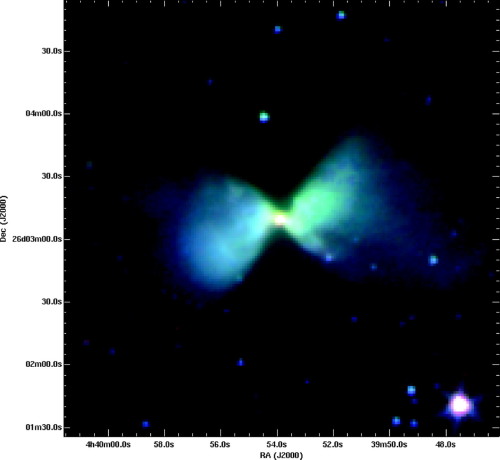 A diminutive stellar blob some 450 million light years away seems to be a young star giving birth to a planetary system much like our very own Solar System. The developing protostar and its surrounding gas cloud is being tracked astronomers at the National Radio Astronomy Observatory in Charlottesville, Virginia. Stellar and planetary evolution in action.
A diminutive stellar blob some 450 million light years away seems to be a young star giving birth to a planetary system much like our very own Solar System. The developing protostar and its surrounding gas cloud is being tracked astronomers at the National Radio Astronomy Observatory in Charlottesville, Virginia. Stellar and planetary evolution in action.
[div class=attrib]From New Scientist:[end-div]
Swaddled in a cloud of dust and gas, the baby star shows a lot of potential. It is quietly sucking in matter from the cloud, which holds enough cosmic nourishment for the infant to grow as big and bright as our sun. What’s more, the star is surrounded by enough raw material to build at least seven planetary playmates.
Dubbed L1527, the star is still in the earliest stages of development, so it offers one of the best peeks yet at what our solar system may have looked like as it was taking shape.
The young star is currently one-fifth of the mass of the sun, but it is growing. If it has been bulking up at the same rate all its life, the star should be just 300,000 years old – a mere tyke compared to our 4.6-billion-year-old sun. But the newfound star may be even younger, because some theories say stars initially grow at a faster rate.
Diminutive sun
The cloud feeding the protostar contains at least as much material as our sun, says John Tobin of the National Radio Astronomy Observatory in Charlottesville, Virginia.
“The key factor in determining a star’s characteristics is the mass, so L1527 could potentially grow to become similar to the sun,” says Tobin.
Material from the cloud is being funnelled to the star through a swirling disc that contains roughly 0.5 per cent the mass of the sun. That might not sound like a lot, but that’s enough mass to make up at least seven Jupiter-sized planets.
Previous observations of L1527 had hinted that a disk encircled the star, but it was not clear that the disk was rotating, which is an essential ingredient for planet formation. So Tobin and his colleagues took a closer look.
Good rotations
The team used radio observations to detect the presence of carbon monoxide around the star and watched how the material swirled around in the disc to trace its overall motion. They found that matter nearest to the star is rotating faster than material near the edge of the disc – a pattern that mirrors the way planets orbit a star.
“The dust and gas are orbiting the protostar much like how planets orbit the sun,” says Tobin. “Unfortunately there is no telling how many planets might form or how large they will be.”
[div class=attrib]Read the entire article following the jump.[end-div]
[div class=attrib]Protostar L1527. Courtesy of NASA / JPL, via tumblr.[end-div]
